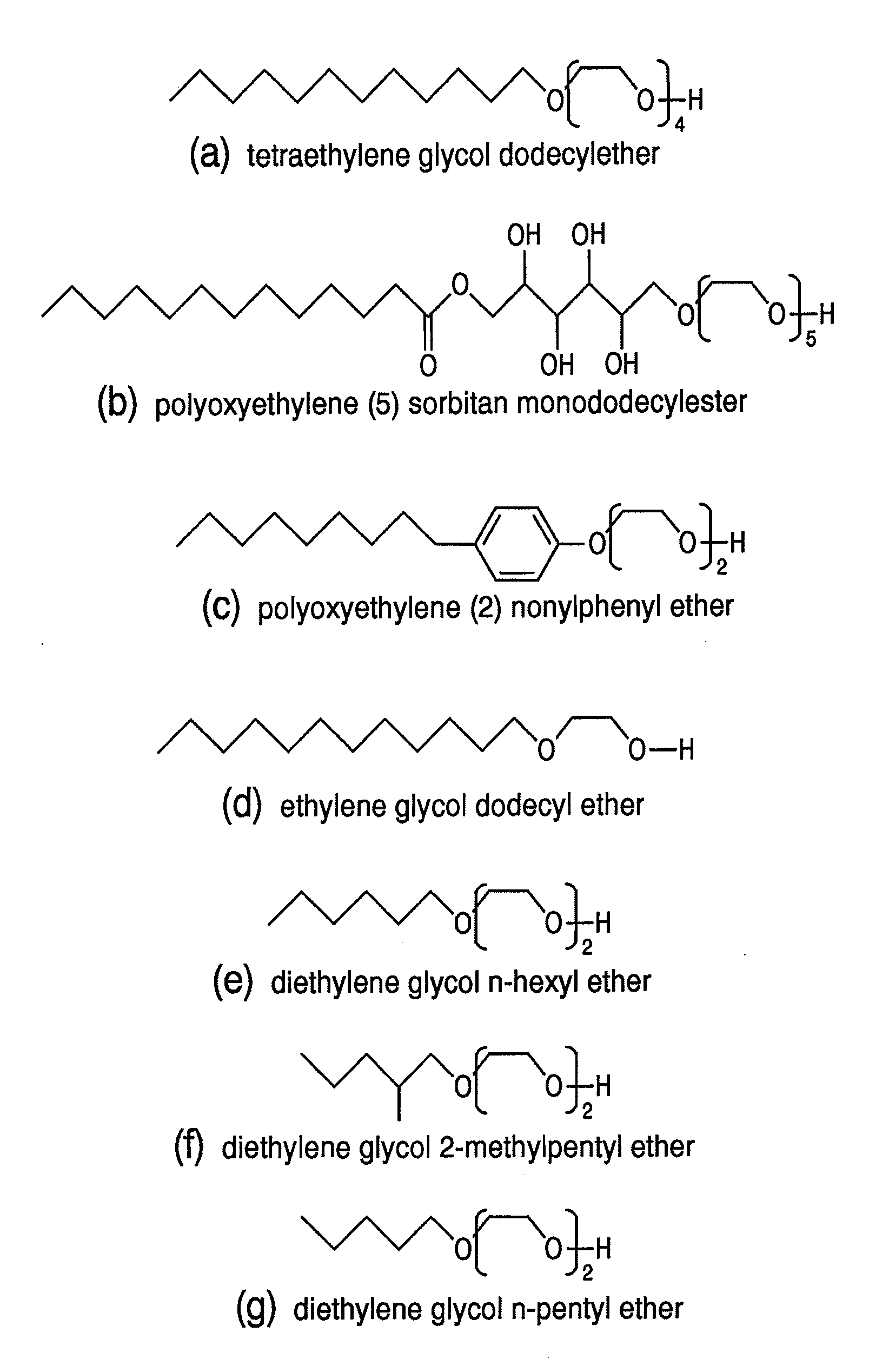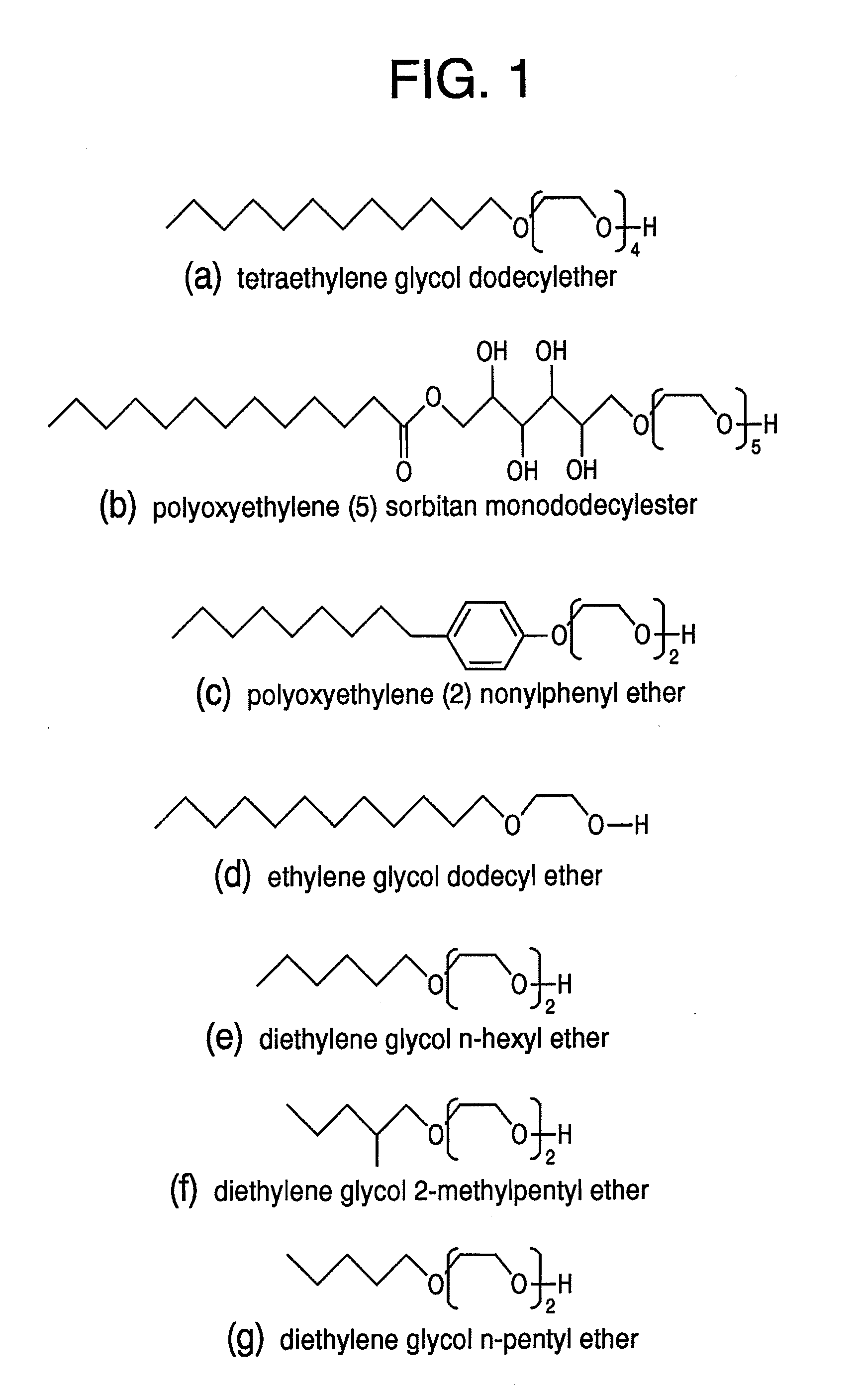Metal nanoparticle and method for producing the same
a technology of metal nanoparticles and nanoparticles, applied in the field of metal nanoparticles, can solve the problems of complex fabrication process, inability to perform original functions, degraded magnetic characteristics of nanoparticles, etc., and achieve the effects of low cost, simple operation and small impact on the environmen
- Summary
- Abstract
- Description
- Claims
- Application Information
AI Technical Summary
Benefits of technology
Problems solved by technology
Method used
Image
Examples
embodiment 1
[0079]First, 40 mg of tris(acetylacetonato)iron (III) and 44 mg of bis(acetylacetonato)platinum (II) are added to 20 ml of tetraethylene glycol dodecylether (cf., FIG. 1, including an alkyl group with carbon number 12) and it is heated at 300° C. for 30 minutes under argon gas atmosphere while agitated. After cooling down the reaction solution to ambient temperature, 400 ml of deionized water is added and a centrifugal separation process is performed. The precipitations are dried in a vacuum of less than or equal to 1.33×103 Pa, after that, the precipitations are monodispersed in toluene. In this manner, a toluene dispersion liquid of FePt nanocrystals, whose surfaces are protected by tetraethylene glycol dodecyl ether, is prepared. After 0.5 M of aqueous solution of mercaptosuccinic is added to 10 ml of the toluene dispersion liquid, it is agitated for one hour at ambient temperature. Then FePt nanocrystals shift from a toluene phase to a water phase. It is verified by the FT-IR me...
embodiment 2
[0080]First, 40 mg of tris(acetylacetonato)cobalt (III) and 44 mg of bis(acetylacetonato)platinum (II) are added to 20 ml of tetraethylene glycol dodecylether (cf., FIG. 1, including an alkyl group with carbon number 12) and it is heated at 300° C. for 30 minutes under argon gas atmosphere while agitated. After cooling down the reaction solution to ambient temperature, 400 ml of deionized water is added and a centrifugal separation process is performed. The precipitations are dried in a vacuum of less than or equal to 1.33×103 Pa, after that, the precipitations are monodispersed in toluene. In this manner, a toluene dispersion liquid of CoPt nanocrystals whose surfaces are protected by tetraethylene glycol dodecyl ether is prepared. After 0.5 M of aqueous solution of mercaptosuccinic is added to 10 ml of the toluene dispersion liquid, it is agitated for one hour at ambient temperature. Then CoPt nanocrystals shift from a toluene phase to a water phase. It is verified by the FT-IR me...
embodiment 3
[0081]First, 31 mg of ferric chloride (III) hexahydrate and 20 mg of palladium chloride (II) are added to 20 ml of polyoxyethylene (5) sorbitan monododecylester (cf., FIG. 1, including an alkyl group with carbon number 12) and it is heated at 300° C. for 30 minutes under argon gas atmosphere while agitated. After cooling down the reaction solution to ambient temperature, 400 ml of deionized water is added and a centrifugal separation process is performed. The precipitations are dried in a vacuum of less than or equal to 1.33×103 Pa, after that, the precipitations are monodispersed in toluene. In this manner, a toluene dispersion liquid of FePd nanocrystals whose surfaces are protected by polyoxyethylene (5) sorbitan monododecylester is prepared. After 0.5 M of aqueous solution of mercaptosuccinic is added to 10 ml of the toluene dispersion liquid, it is agitated for one hour at ambient temperature. Then FePd nanocrystals shift from a toluene phase to a water phase. It is verified by...
PUM
| Property | Measurement | Unit |
|---|---|---|
| Temperature | aaaaa | aaaaa |
| Length | aaaaa | aaaaa |
| Length | aaaaa | aaaaa |
Abstract
Description
Claims
Application Information
 Login to View More
Login to View More - R&D
- Intellectual Property
- Life Sciences
- Materials
- Tech Scout
- Unparalleled Data Quality
- Higher Quality Content
- 60% Fewer Hallucinations
Browse by: Latest US Patents, China's latest patents, Technical Efficacy Thesaurus, Application Domain, Technology Topic, Popular Technical Reports.
© 2025 PatSnap. All rights reserved.Legal|Privacy policy|Modern Slavery Act Transparency Statement|Sitemap|About US| Contact US: help@patsnap.com


